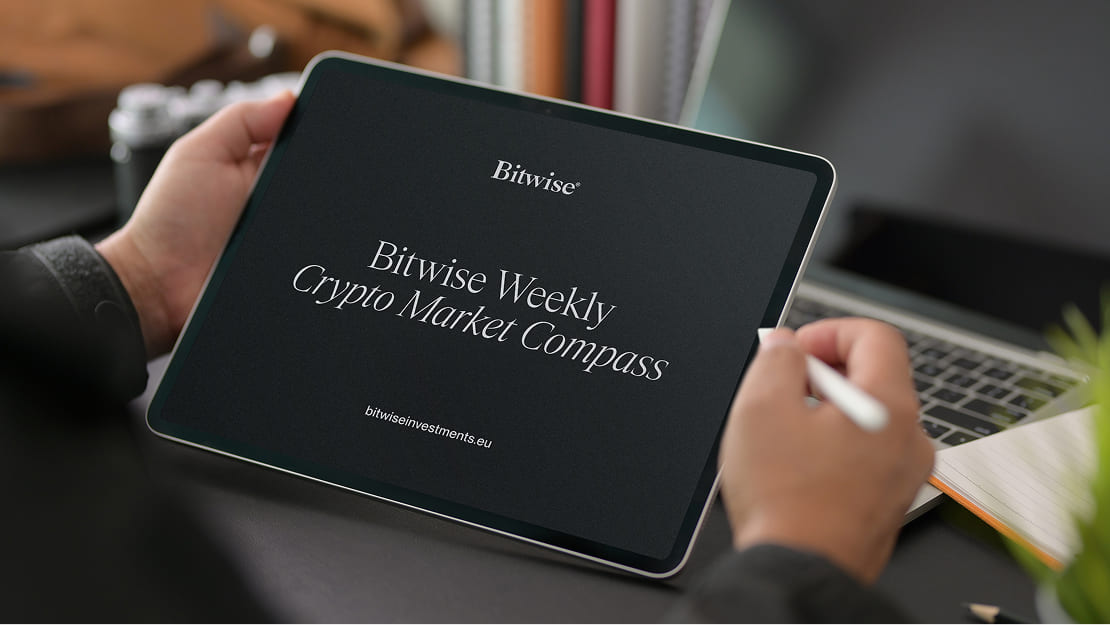- Last week, cryptoassets sold off significantly due to renewed geopolitical tensions between the US and China. The selloff was not confined to cryptoassets alone as all asset classes were negatively affected.
- Our in-house “Cryptoasset Sentiment Index” declined to the lowest level since the “Yen Carry Trade Unwind” in early August 2024 signalling a significant degree of seller exhaustion. A clean contrarian buying signal was triggered.
- Chart of the Week: Before the selloff, Bitcoin was trading near its all-time highs. The subsequent drop was intensified by an unprecedented wave of long futures liquidations, with perpetual futures open interest plunging by nearly $11 billion — the largest decline on record
Chart of the Week
Futures Perpetual Open Interest Daily Change
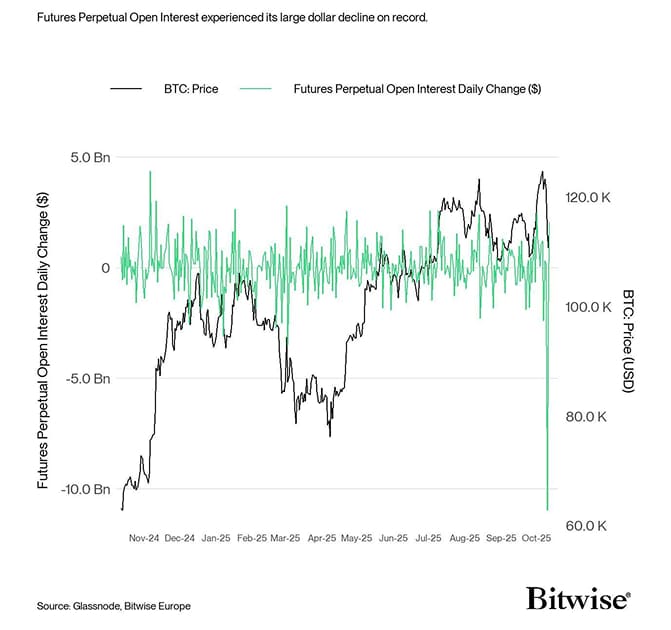
Performance
Last week, cryptoassets sold off significantly due to renewed geopolitical tensions between the US and China. The selloff was not confined to cryptoassets alone as all asset classes were negatively affected. For instance, the NASDAQ 100 was down -3.5% and the S&P 500 was down -2.7% on Friday, respectively.
A key catalyst for the selloff was Trump's post on Friday evening to increase tariffs on imports from China by an additional 100% in retaliation against export restrictions on rare earth metals recently announced by China.
Before that selloff, bitcoin had been trading near all-time highs. The downside move was exacerbated by long futures liquidations that reached unprecedented levels. Bitcoin's perpetual futures open interest alone declined by almost -$11 billion – the strongest decline on record (Chart-of-the-Week).
In particular, Asian futures exchanges saw a downside cascade that was exacerbated by so-called auto-liquidations where exchanges automatically start to liquidate long positions pre-emptively when traders can't maintain the mandatory margin requirements anymore.
As a result, bitcoin reached an intraday low of slightly below $105k while ether traded as low as $3,500 on Friday night.
On a positive note, these liquidations have led to a meaningful exhaustion of selling pressure which implies that further downside is very unlikely.
More specifically, our intraday Cryptoasset Sentiment Index has declined to the lowest level since the “Yen Carry Trade Unwind” in early August 2024 which is clearly signalling a contrarian buying opportunity.
Therefore, we think that this flush out in leverage represents a very attractive opportunity to increase exposure into a seasonally strong Q4 once again especially in light of the strong macro tailwinds described in our most recent monthly report.
The very latest geopolitical developments also imply a renewed relaxation of trade tensions which has led to a sharp recovery in cryptoasset prices over the weekend already. At the time of writing this report on Monday morning, bitcoin is up by almost +10% since the intraday low on Friday and ether is even trading +19% higher.
That being said, many analysts have rated Trump's most recent statements as not being particularly friendly towards Chinese president Xi Jinping.
It is quite likely that crypto markets will remain somewhat volatile because of this ongoing trade spat. Nonetheless, US equity futures are also trading higher this morning confirming the recovery in cryptoassets and overall risk sentiment.
Cross Asset Performance (Week-to-Date)
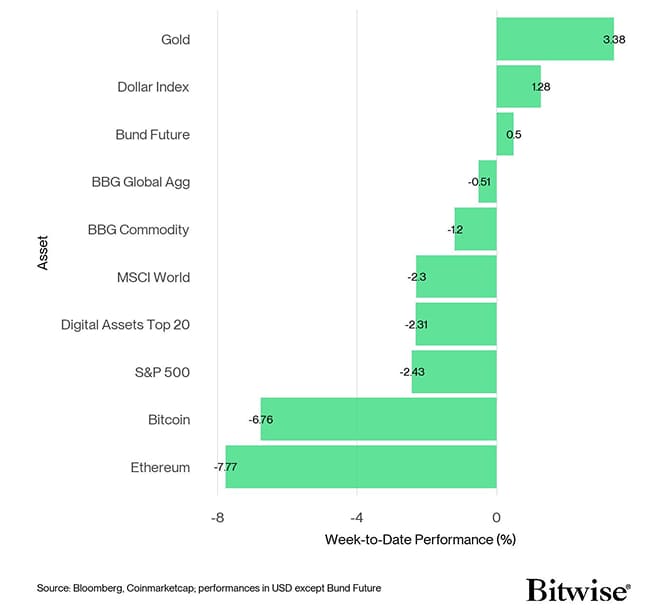 Source: Bloomberg, Coinmarketcap; performances in USD exept Bund Future
Top 10 Cryptoasset Performance (Week-to-Date)
Source: Bloomberg, Coinmarketcap; performances in USD exept Bund Future
Top 10 Cryptoasset Performance (Week-to-Date)
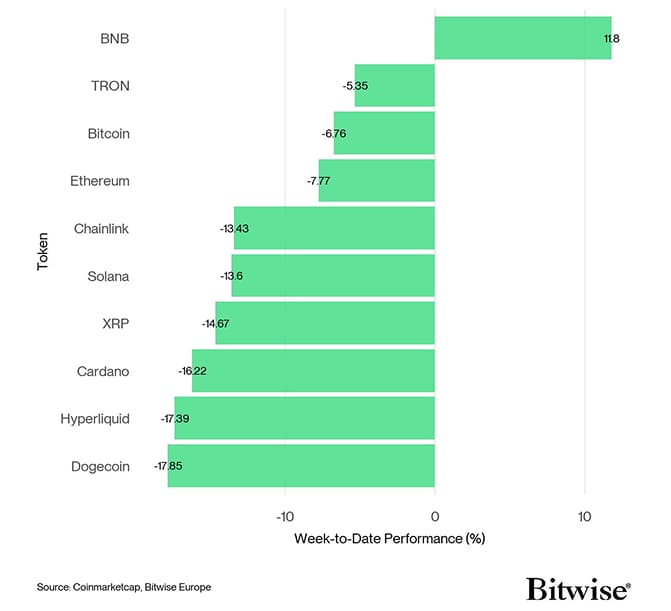 Source: Coinmarketcap
Source: Coinmarketcap
In general, among the top 10 crypto assets BNB, TRON, and Bitcoin were the relative outperformers.
Overall, altcoin outperformance vis-à-vis bitcoin has continued to be low last week, with only 20% of our tracked altcoins managing to outperform bitcoin on a weekly basis. Ethereum also slightly underperformed bitcoin last week.
Sentiment
Our in-house “Cryptoasset Sentiment Index” declined to the lowest level since the “Yen Carry Trade Unwind” in early August 2024 signalling a significant degree of seller exhaustion. A clean contrarian buying signal was triggered.
At the moment, 3 out of 15 indicators are above their short-term trend.
Last week, the Crypto Hedge Fund Beta and the BTC Exchange Inflows metrics showed positive momentum.
The Crypto Fear & Greed Index currently signals a “Fear” level of sentiment as of this morning, with the index dropping into “Extreme Fear” levels yesterday as a result of the selloff.
Performance dispersion among cryptoassets has trended down slightly last week, signalling that altcoins have continued to be highly correlated with the performance of bitcoin.
Altcoin outperformance vis-à-vis Bitcoin has decreased from last week, with around 20% of our tracked altcoins managing to outperform Bitcoin on a weekly basis. Ethereum also slightly underperformed Bitcoin last week.
In general, increasing (decreasing) altcoin outperformance tends to be a sign of increasing (decreasing) risk appetite within cryptoasset markets and the latest altcoin outperformance signals an increasing risk appetite at the moment.
Sentiment in traditional financial markets as measured by our in-house measure of Cross Asset Risk Appetite (CARA) has dropped dramatically. As a result of the events over the weekend, our readings show a drop from 0.71 to 0.23
Fund Flows
While weekly fund flows into global crypto ETPs decelerated last week, inflows across Bitcoin, Ethereum, and ex-Ethereum altcoin products still suggest steady allocation. Baskets & Thematics however saw net outflows last week.
Global crypto ETPs saw around +2948.0 mn USD in weekly net inflows across all types of cryptoassets, after +5665.3 mn USD in net inflows the previous week.
Global Bitcoin ETPs have continued to experience net inflows totalling +2581.4 USD last week, of which +2714.7 mn USD in net inflows were related to US spot Bitcoin ETFs.
The Bitwise Bitcoin ETF (BITB) in the US experienced net inflows, totalling +42.7 mn USD last week.
In Europe, the Bitwise Physical Bitcoin ETP (BTCE) experienced net outflows equivalent to -3.5 mn USD, while the Bitwise Core Bitcoin ETP (BTC1) experienced minor net inflows of +5.9 mn USD.
The Grayscale Bitcoin Trust (GBTC) has posted net outflows of -93.4 mn USD. The iShares Bitcoin Trust (IBIT), however, experienced net inflows of around +2625.3 mn USD last week.
Meanwhile, flows into global Ethereum ETPs maintained its positive trend last week, with around + 307.5 mn USD in net inflows.
US spot Ethereum ETFs, also recorded net inflows of around +488.3 mn USD on aggregate. The Grayscale Ethereum Trust (ETHE), has posted net outflows of -32.5 mn USD.
The Bitwise Ethereum ETF (ETHW) in the US has also posted net outflows of -2.7 mn USD.
In Europe, the Bitwise Physical Ethereum ETP (ZETH) saw net inflows of +11.4 mn USD while the Bitwise Ethereum Staking ETP (ET32) saw minor net inflows of +1.0 mn USD.
Altcoin ETPs ex Ethereum also experienced net inflows of +110.1 mn USD last week.
Thematic & basket crypto ETPs, however, posted net outflows of -51.0 mn USD on aggregate last week. The Bitwise MSCI Digital Assets Select 20 ETP (DA20) saw minor net inflows of +0.1 mn USD.
Global crypto hedge funds exposure to Bitcoin rose modestly early last week before reversing. The 20-day rolling beta of hedge fund performance to Bitcoin began the week higher but closed yesterday around 0.75.
On-Chain Data
Intraday Spot Buying minus Selling volume continued to be negative but accelerated last week with net selling volumes at approximately -$2.28 bn on bitcoin spot exchanges by week-end.
Bitcoin whales (entities that hold at least 1k BTC) have exhibited a notable shift in behaviour following the recent market correction, transitioning from accumulation to net distribution. Over the past week, these large holders collectively deposited approximately +13.1K BTC to exchanges, signalling a rise in whale-driven sell-side pressure.
Furthermore, based on recent data from Glassnode, the overall downward trend in exchange-held Bitcoin reserves has continued its downward trend. The current level stands at 2.819 million BTC, representing approximately 14.10% of the total circulating supply - a 68 bps decrease from last week.
During the recent sell-off, the altcoin sector bore the brunt of the decline, with realized losses mounting significantly across major assets. Ethereum, XRP, Solana, and Dogecoin recorded losses of –$411 mn, –$240 mn, –$712 mn, and –$256 mn, respectively, highlighting the intensity of the capitulation event. Additionally, the aggregate altcoin market cap experienced a decline of $118 bn, with only 2 trading days recording a steeper duation.
Notably, Bitcoin demonstrated significantly greater resilience compared to its altcoin counterparts, resulting in the Bitcoin Dominance metric rising to 60.1%. Moreover, the one-day increase in Bitcoin Dominance ranked as the 12th largest on record, underscoring Bitcoin's relative strength and market leadership amid the recent turbulence.
A key observation is that the market momentarily fell below the Short-Term Holder cost-basis ($114K) during the decline but quickly rebounded to reclaim this crucial level. Since this metric is often regarded as a boundary between local bull and bear market conditions, it's essential for the market to hold above this level to support continued recovery.
All in all, on-chain metrics underscore the severity of the recent market sell-off, with whale entities shifting from accumulation to distribution and the altcoin sector bearing the brunt of the decline. Bitcoin, however, remained comparatively resilient, driving dominance higher and reclaiming its Short-Term Holder cost-basis, a key threshold supporting the case for a gradual market recovery.
Futures, Options & Perpetuals
Last week, BTC futures open interest decreased by –65.8k BTC across all exchanges and decreased by -2.7k BTC on CME. Meanwhile, perpetual open interest decreased by around -69.5k BTC, equivalent to -$12.2bn, an all-time record event.
The recent market sell-off, driven by headline-sensitive sentiment and excessive open interest, triggered a liquidation cascade totalling an unprecedented $19.2 billion, the largest liquidation event ever recorded in digital asset markets.
BTC perpetual funding remained positive throughout last week on all days but one (Friday) indicating excessively bullish sentiment among traders in the perpetual futures market and a long bias. Friday was the third most negative day year-over-year as traders scrambled for short positions amongst the long liquidation frenzy.
In general, when the funding rate is positive (negative), long (short) positions periodically pay short (long) positions, which is indicative of bullish (bearish) sentiment.
The BTC 3-months annualised basis decreased last week to around 8.0% p.a., averaged across various futures exchanges.
BTC option open interest increased by around +69.1k BTC while the put-call open interest ratio increased slightly to 0.64. We observed some spikes in the put-call volume ratio indicating an increasing appetite for downside protection during this pull-back.
Meanwhile, the 1-month 25-delta skew for BTC rose over the week from +3.14% to +8.69%, reflecting a growing appetite for put options and heightened demand for downside protection. While the skew has begun to moderate in the aftermath of the market sell-off, the presence of a positive skew still indicates a preference for downside protection.
BTC option implied volatilities increased slightly compared to last week, consistent with the increase in 1-month realized volatility.
At the time of writing, implied volatilities of 1-month ATM Bitcoin options are currently at around 43.71% p.a. on Deribit, the highest level since beginning of June 2025.
Bottom Line
- Last week, cryptoassets sold off significantly due to renewed geopolitical tensions between the US and China. The selloff was not confined to cryptoassets alone as all asset classes were negatively affected.
- Our in-house “Cryptoasset Sentiment Index” declined to the lowest level since the “Yen Carry Trade Unwind” in early August 2024 signalling a significant degree of seller exhaustion. A clean contrarian buying signal was triggered.
- Chart of the Week: Before the selloff, Bitcoin was trading near its all-time highs. The subsequent drop was intensified by an unprecedented wave of long futures liquidations, with perpetual futures open interest plunging by nearly $11 billion — the largest decline on record
Appendix
Bitcoin Price vs Cryptoasset Sentiment Index
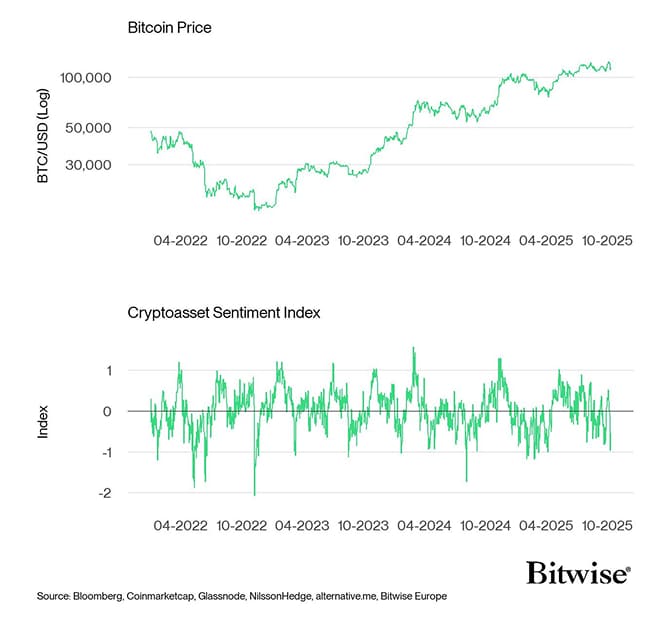 Source: Bloomberg, Coinmarketcap, Glassnode, NilssonHedge, alternative.me, Bitwise Europe
Cryptoasset Sentiment Index
Source: Bloomberg, Coinmarketcap, Glassnode, NilssonHedge, alternative.me, Bitwise Europe
Cryptoasset Sentiment Index
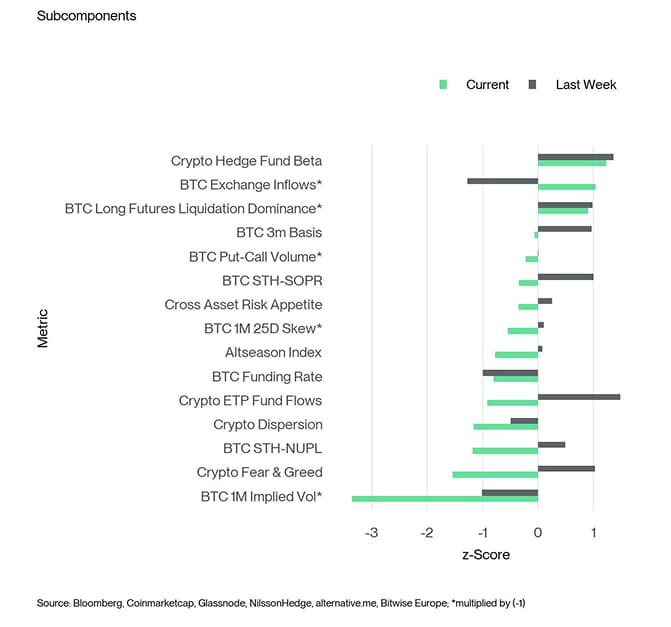 Source: Bloomberg, Coinmarketcap, Glassnode, NilssonHedge, alternative.me, Bitwise Europe; *multiplied by (-1)
Cryptoasset Sentiment Index
Source: Bloomberg, Coinmarketcap, Glassnode, NilssonHedge, alternative.me, Bitwise Europe; *multiplied by (-1)
Cryptoasset Sentiment Index
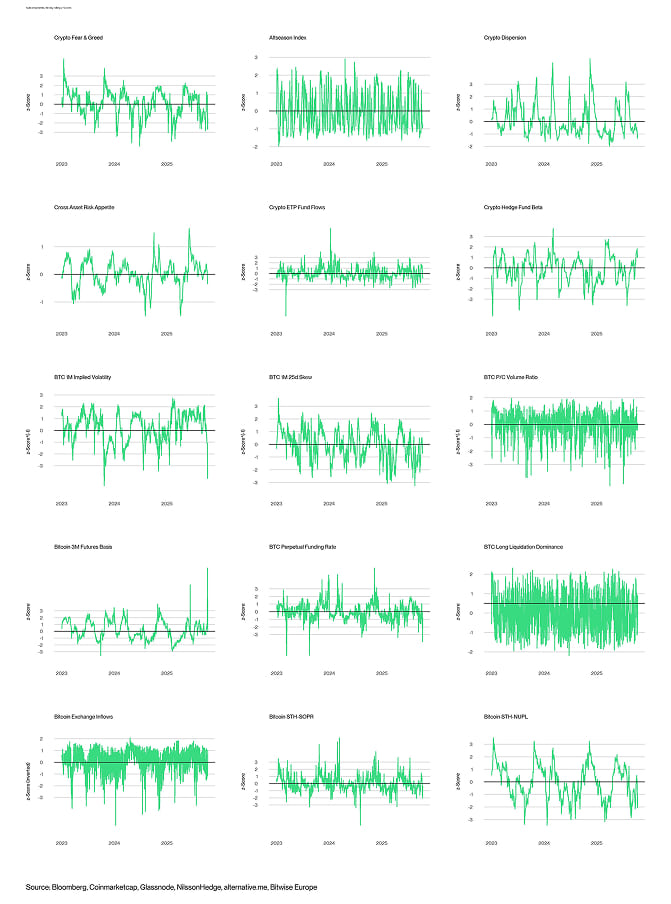 Source: Bloomberg, Coinmarketcap, Glassnode, NilssonHedge, alternative.me, Bitwise Europe
TradFi Sentiment Indicators
Source: Bloomberg, Coinmarketcap, Glassnode, NilssonHedge, alternative.me, Bitwise Europe
TradFi Sentiment Indicators
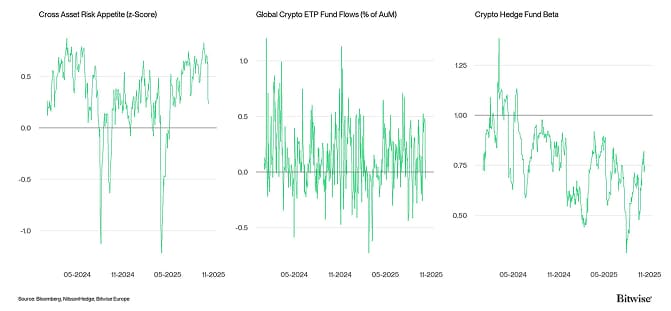 Source: Bloomberg, NilssonHedge, Bitwise Europe
Crypto Sentiment Indicators
Source: Bloomberg, NilssonHedge, Bitwise Europe
Crypto Sentiment Indicators
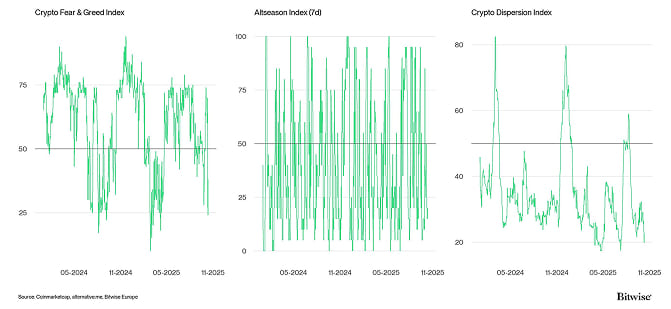 Source: Coinmarketcap, alternative.me, Bitwise Europe
Crypto Options' Sentiment Indicators
Source: Coinmarketcap, alternative.me, Bitwise Europe
Crypto Options' Sentiment Indicators
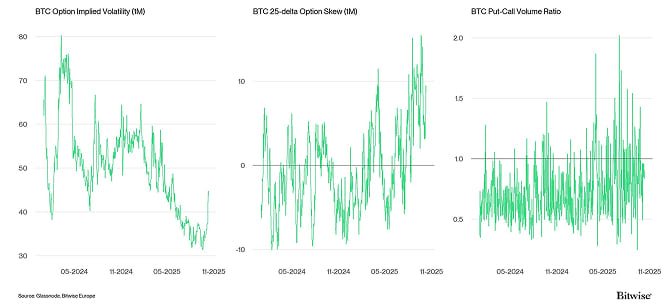 Source: Glassnode, Bitwise Europe
Crypto Futures & Perpetuals' Sentiment Indicators
Source: Glassnode, Bitwise Europe
Crypto Futures & Perpetuals' Sentiment Indicators
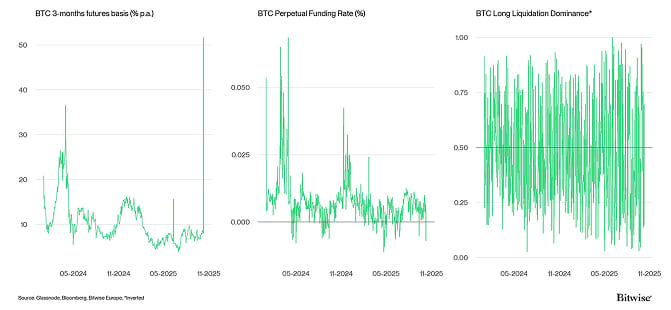 Source: Glassnode, Bitwise Europe; *Inverted
Crypto On-Chain Indicators
Source: Glassnode, Bitwise Europe; *Inverted
Crypto On-Chain Indicators
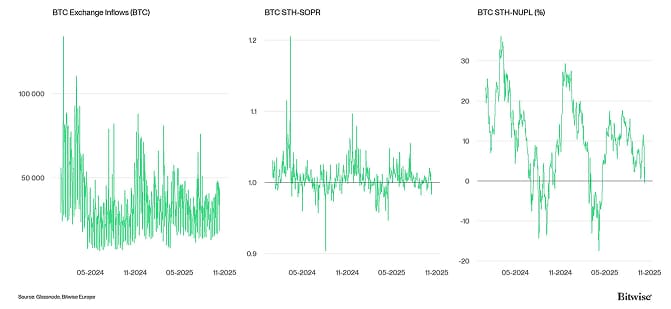 Source: Glassnode, Bitwise Europe
Bitcoin vs Crypto Fear & Greed Index
Source: Glassnode, Bitwise Europe
Bitcoin vs Crypto Fear & Greed Index
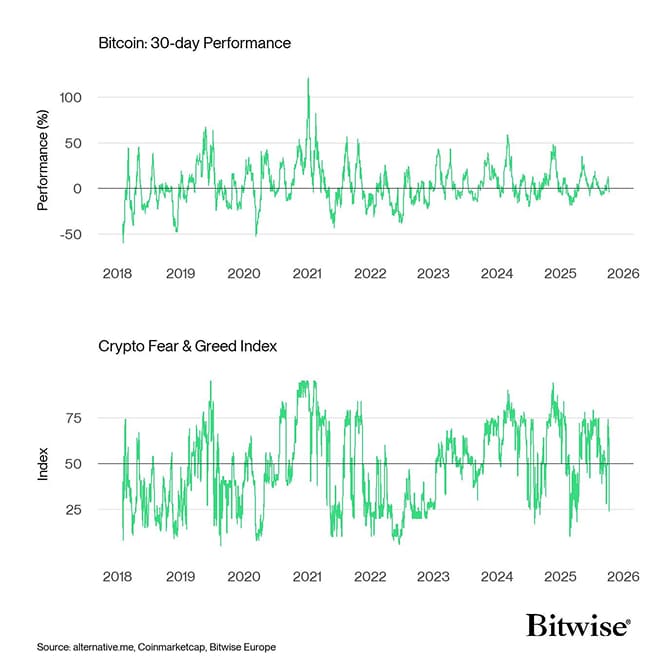 Source: alternative.me, Coinmarketcap, Bitwise Europe
Cryptoasset Sentiment Index: Daily vs Hourly
Source: alternative.me, Coinmarketcap, Bitwise Europe
Cryptoasset Sentiment Index: Daily vs Hourly
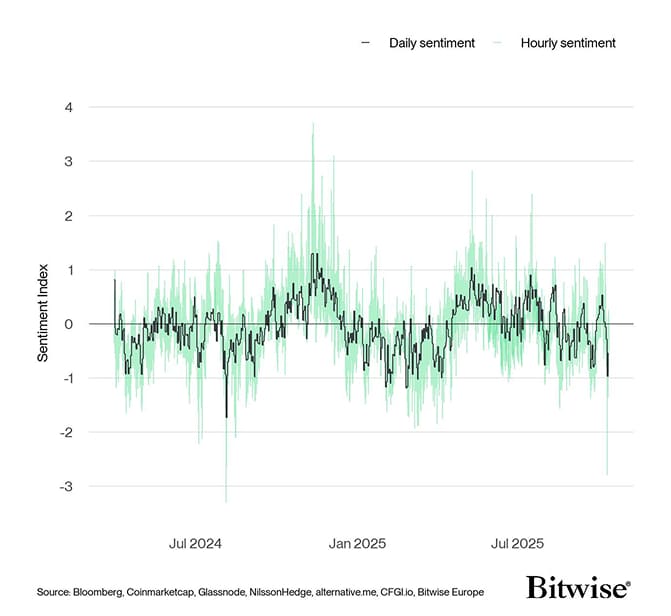 Source: Bloomberg, Coinmarketcap, Glassnode, NilssonHedge, alternative.me, CFGI.io, Bitwise Europe
Bitcoin vs Global Crypto ETP Fund Flows
Source: Bloomberg, Coinmarketcap, Glassnode, NilssonHedge, alternative.me, CFGI.io, Bitwise Europe
Bitcoin vs Global Crypto ETP Fund Flows
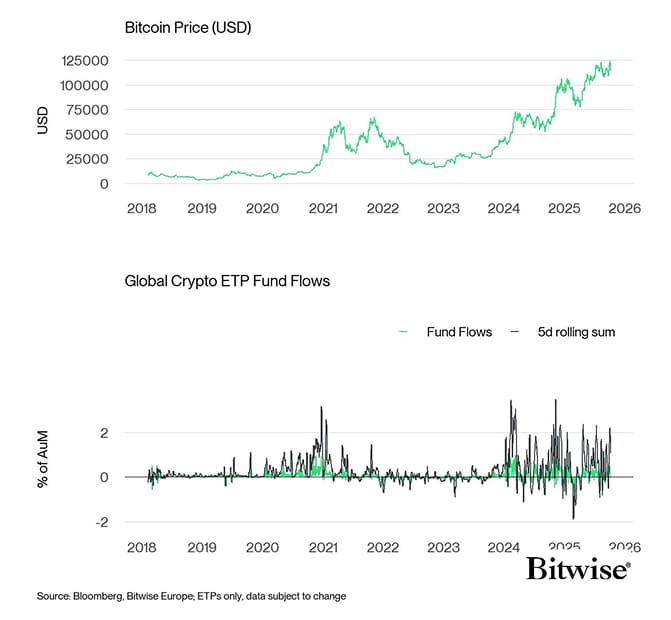 Source: Bloomberg, Bitwise Europe; ETPs only, data subject to change
Global Crypto ETP Fund Flows
Source: Bloomberg, Bitwise Europe; ETPs only, data subject to change
Global Crypto ETP Fund Flows
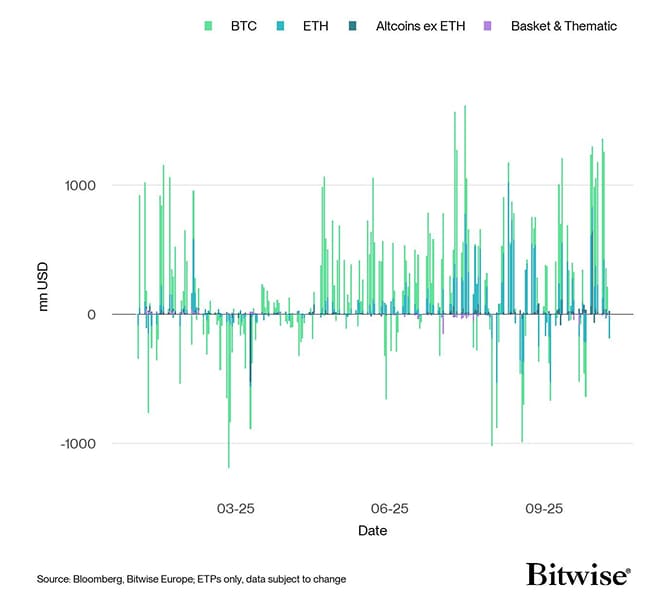 Source: Bloomberg, Bitwise Europe; ETPs only; data subject to change
US Spot Bitcoin ETF Fund Flows
Source: Bloomberg, Bitwise Europe; ETPs only; data subject to change
US Spot Bitcoin ETF Fund Flows
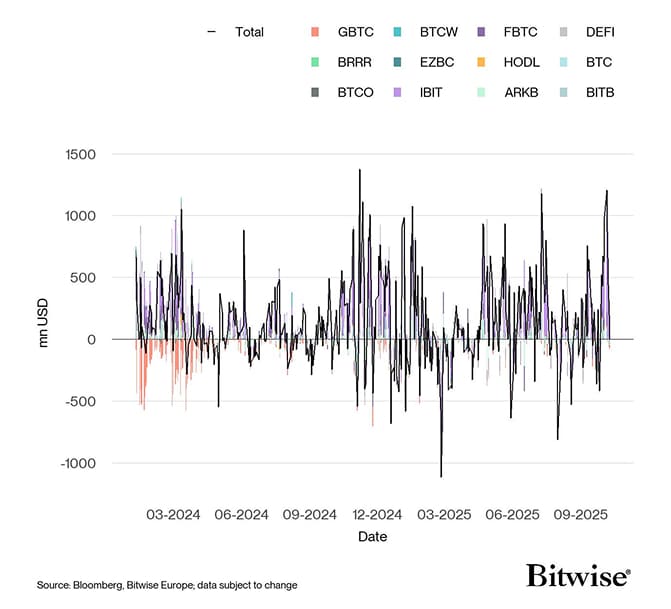 Source: Bloomberg, Bitwise Europe; data subject to change
US Spot Bitcoin ETFs: Flows since launch
Source: Bloomberg, Bitwise Europe; data subject to change
US Spot Bitcoin ETFs: Flows since launch
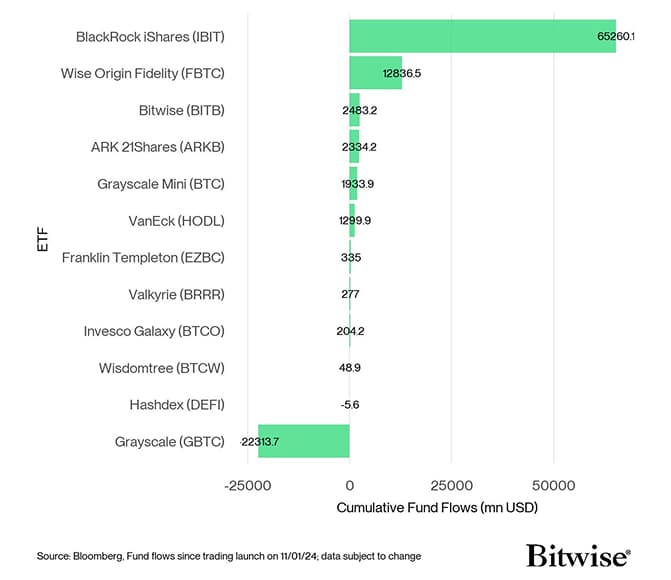 Source: Bloomberg, Fund flows since traiding launch on 11/01/24; data subject to change
US Spot Bitcoin ETFs: 5-days flow
Source: Bloomberg, Fund flows since traiding launch on 11/01/24; data subject to change
US Spot Bitcoin ETFs: 5-days flow
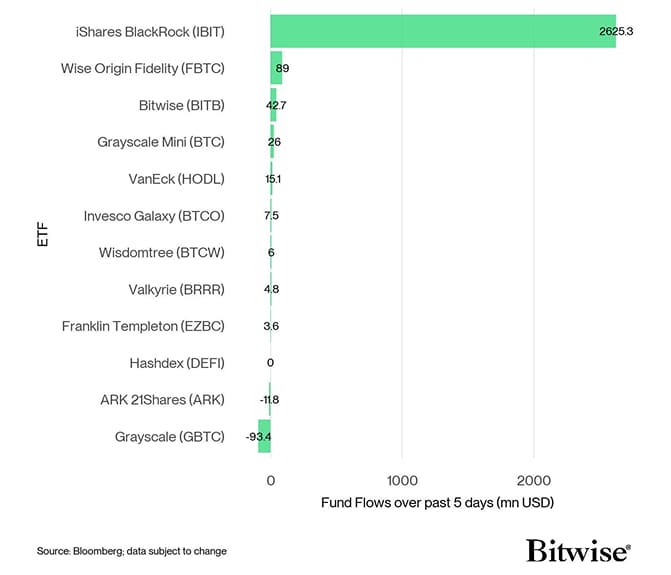 Source: Bloomber; data subject to change
US Bitcoin ETFs: Net Fund Flows since 11th Jan mn USD
Source: Bloomber; data subject to change
US Bitcoin ETFs: Net Fund Flows since 11th Jan mn USD
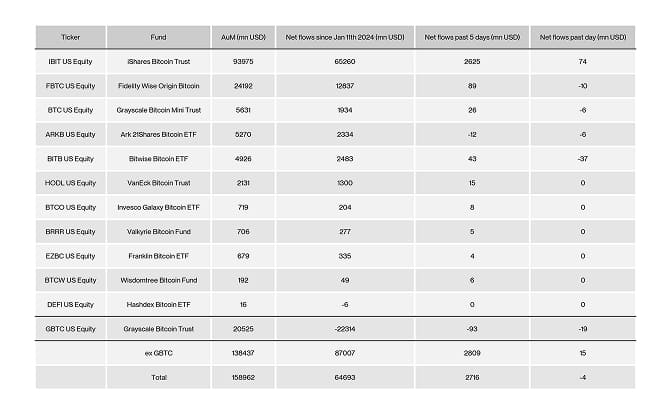 Source: Bloomberg, Bitwise Europe; data as of 10-10-2025
US Spot Ethereum ETF Fund Flows
Source: Bloomberg, Bitwise Europe; data as of 10-10-2025
US Spot Ethereum ETF Fund Flows
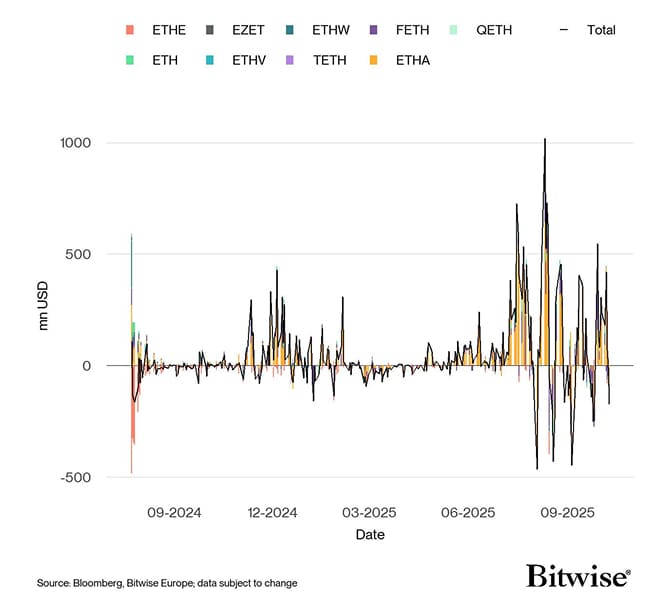 Source: Bloomberg, Bitwise Europe; data subject to change
US Spot Ethereum ETFs: Flows since launch
Source: Bloomberg, Bitwise Europe; data subject to change
US Spot Ethereum ETFs: Flows since launch
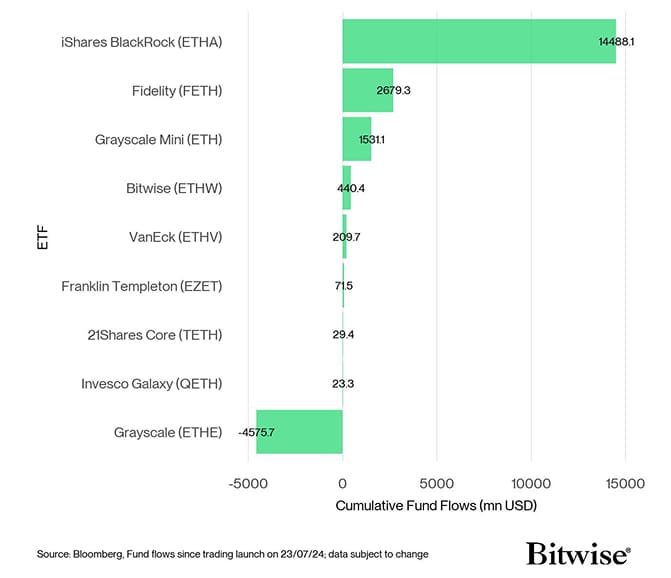 Source: Bloomberg, Fund flows since trading launch on 23/07/24; data subject on change
US Spot Ethereum ETFs: 5-days flow
Source: Bloomberg, Fund flows since trading launch on 23/07/24; data subject on change
US Spot Ethereum ETFs: 5-days flow
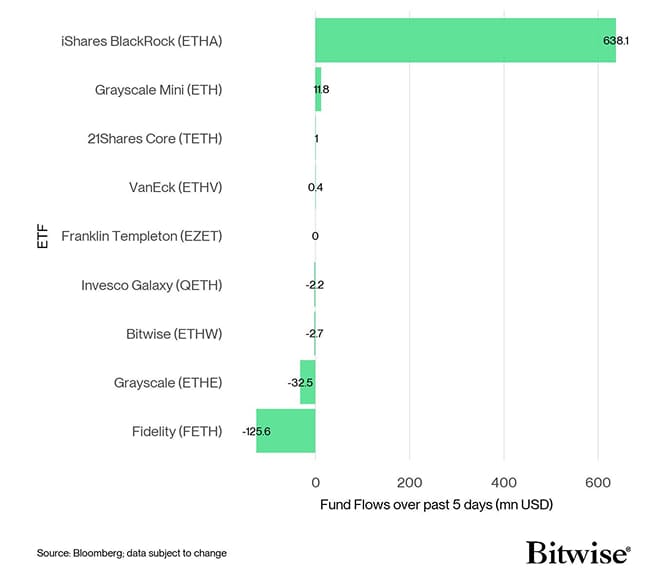 Source: Bloomberg; data subject on change
US Ethereum ETFs: Net Fund Flows since 23rd July
Source: Bloomberg; data subject on change
US Ethereum ETFs: Net Fund Flows since 23rd July
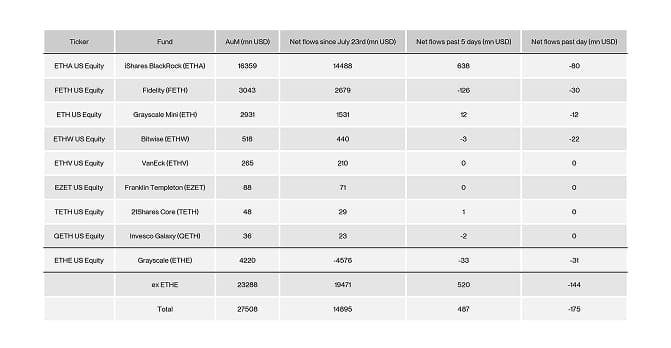 Source: Bloomberg, Bitwise Europe; data as of 10-10-2025
Bitcoin vs Crypto Hedge Fund Beta
Source: Bloomberg, Bitwise Europe; data as of 10-10-2025
Bitcoin vs Crypto Hedge Fund Beta
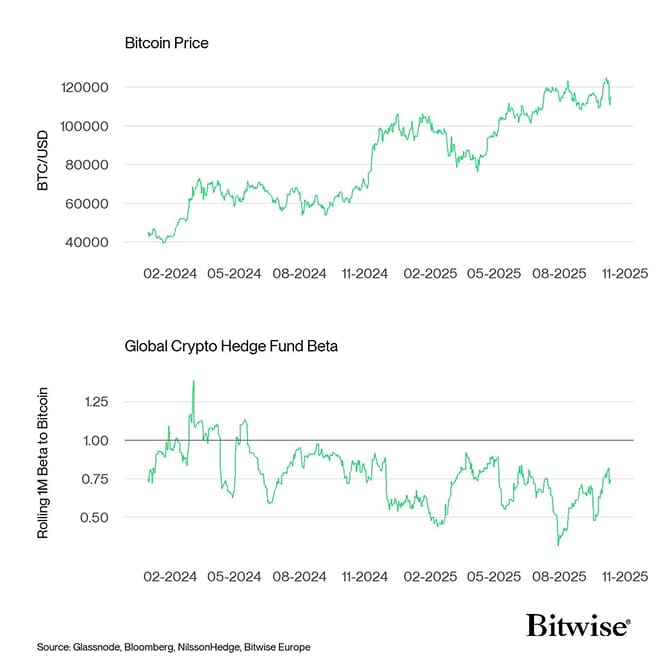 Source: Glassnode, Bloomberg, NilssonHedge, Bitwise Europe
Altseason Index
Source: Glassnode, Bloomberg, NilssonHedge, Bitwise Europe
Altseason Index
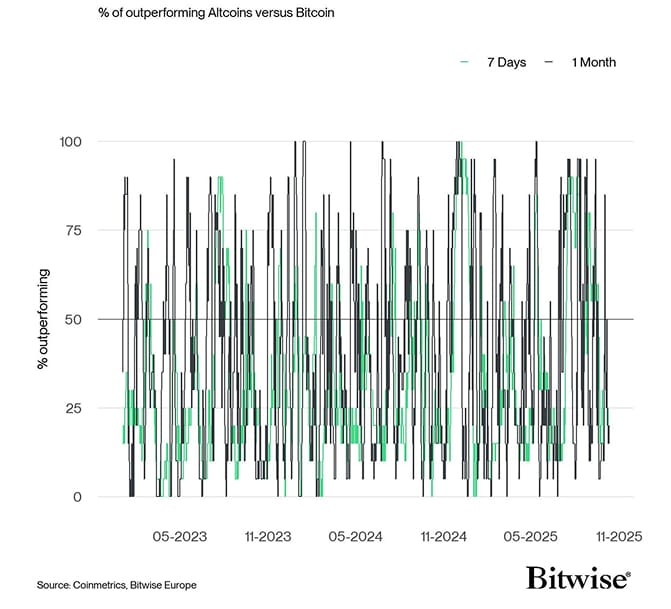 Source: Coinmetrics, Bitwise Europe
Bitcoin vs Crypto Dispersion Index
Source: Coinmetrics, Bitwise Europe
Bitcoin vs Crypto Dispersion Index
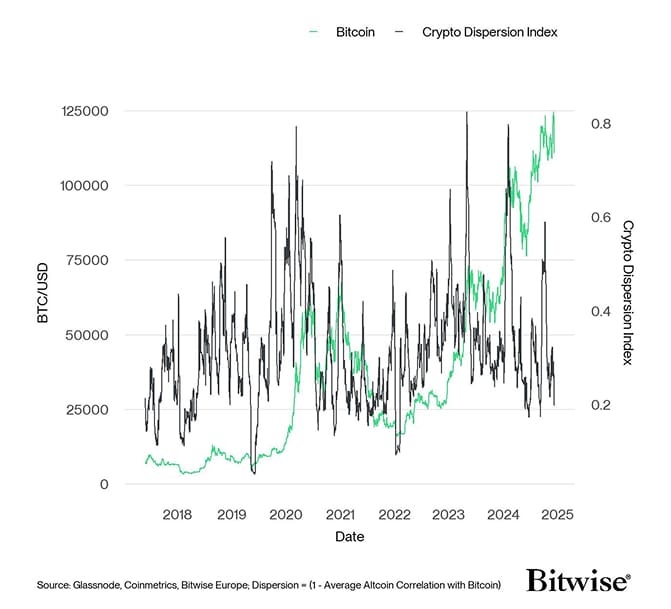 Source: Coinmarketcap, Bitwise Europe; Dispersion = (1 - Average Altcoin Correlation with Bitcoin)
Bitcoin Price vs Futures Basis Rate
Source: Coinmarketcap, Bitwise Europe; Dispersion = (1 - Average Altcoin Correlation with Bitcoin)
Bitcoin Price vs Futures Basis Rate
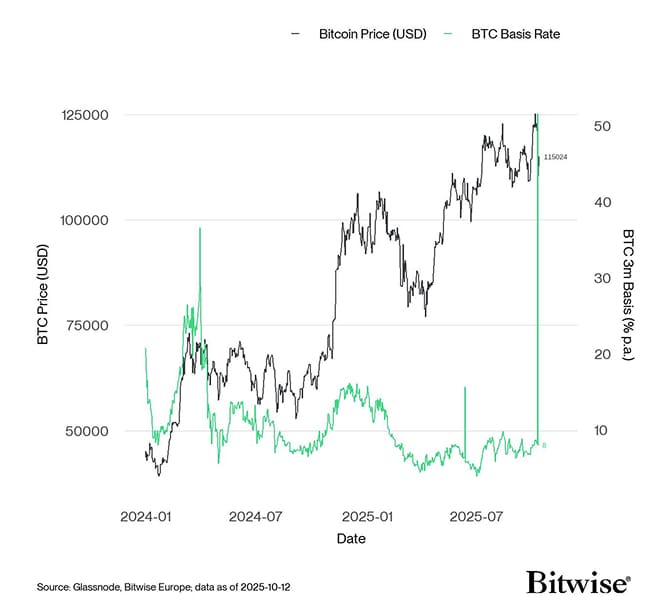 Source: Glassnode, Bitwise Europe; data as of 2025-10-12
Ethereum Price vs Futures Basis Rate
Source: Glassnode, Bitwise Europe; data as of 2025-10-12
Ethereum Price vs Futures Basis Rate
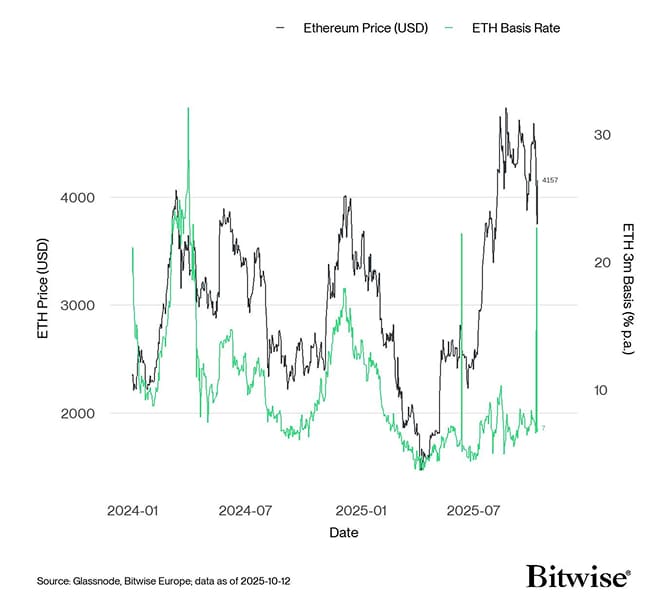 Source: Glassnode, Bitwise Europe; data as of 2025-10-12
BTC Net Exchange Volume by Size
Source: Glassnode, Bitwise Europe; data as of 2025-10-12
BTC Net Exchange Volume by Size
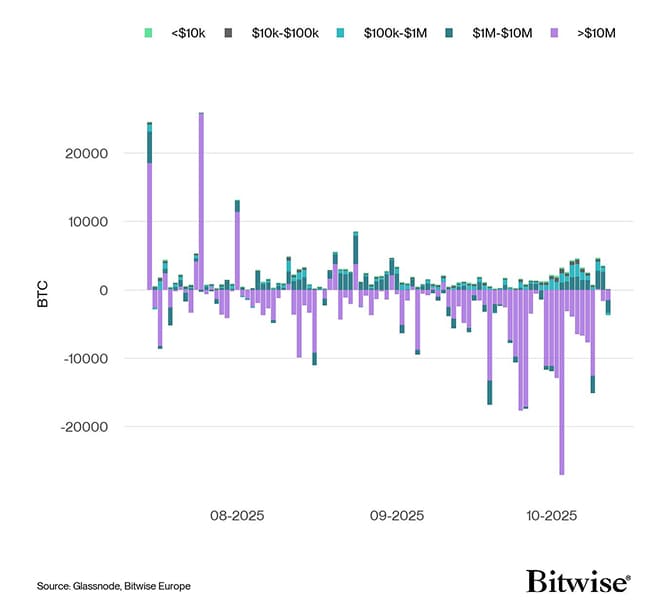 Source: Glassnode, Bitwise Europe
Source: Glassnode, Bitwise Europe
Important information:
This article does not constitute investment advice, nor does it constitute an offer or solicitation to buy financial products. This article is for general informational purposes only, and there is no explicit or implicit assurance or guarantee regarding the fairness, accuracy, completeness, or correctness of this article or the opinions contained therein. It is advised not to rely on the fairness, accuracy, completeness, or correctness of this article or the opinions contained therein. Please note that this article is neither investment advice nor an offer or solicitation to acquire financial products or cryptocurrencies.
Before investing in crypto ETPs, potentional investors should consider the following:
Potential investors should seek independent advice and consider relevant information contained in the base prospectus and the final terms for the ETPs, especially the risk factors mentioned therein. The invested capital is at risk, and losses up to the amount invested are possible. The product is subject to inherent counterparty risk with respect to the issuer of the ETPs and may incur losses up to a total loss if the issuer fails to fulfill its contractual obligations. The legal structure of ETPs is equivalent to that of a debt security. ETPs are treated like other securities.
